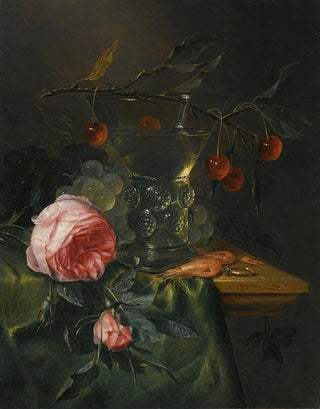Art print | Still life with a cherry branch on a conical Römer half-filled with red and green grapes - Pieter de Ring


View from behind

Frame (optional)
In the fascinating world of 17th-century Flemish painting, Pieter de Ring's work stands out for its delicacy and meticulous attention to detail. The art print with a cherry branch on a conical Römer half-filled with red and green grapes embodies this tradition, where each element is carefully arranged to create visual harmony. Through this composition, the artist invites us to contemplate the fleeting beauty of nature, while evoking an atmosphere of serenity and refinement. The vibrant colors of the grapes, combined with the softness of the cherry blossoms, form a tableau that is both lively and soothing, capturing a moment of life that transcends time.
Style and uniqueness of the work
Pieter de Ring's style is characterized by an exceptional mastery of chiaroscuro and a meticulous attention to the texture of objects. In this art print, light plays a fundamental role, highlighting the reflections on the conical Römer and the transparency of the grapes. The shades of green and red of the fruits, combined with the delicate whiteness of the flowers, create a striking contrast that draws the eye and enriches the visual experience. Every detail, from the grain of the wood of the Römer to the delicacy of the petals, demonstrates attentive observation of reality. The work does not merely depict objects; it elevates them to the level of art, celebrating the beauty of simple things. This unique approach makes Pieter de Ring a master of the art print, capable of transforming ordinary elements into an extraordinary composition.
The artist and his influence
Pieter de Ring, active in Amsterdam in the 17th century, is often regarded as an heir to the great masters of Flemish painting. His work continues a tradition that values the art print as a genre in its own right. Influenced by artists such as Jan Davidsz de Heem, de Ring develops a personal style that combines technical precision with aesthetic sensitivity. His influence extends beyond his era, inspiring many contemporary and future artists to explore the beauty of everyday objects. By integrating elements

Matte finish

View from behind

Frame (optional)
In the fascinating world of 17th-century Flemish painting, Pieter de Ring's work stands out for its delicacy and meticulous attention to detail. The art print with a cherry branch on a conical Römer half-filled with red and green grapes embodies this tradition, where each element is carefully arranged to create visual harmony. Through this composition, the artist invites us to contemplate the fleeting beauty of nature, while evoking an atmosphere of serenity and refinement. The vibrant colors of the grapes, combined with the softness of the cherry blossoms, form a tableau that is both lively and soothing, capturing a moment of life that transcends time.
Style and uniqueness of the work
Pieter de Ring's style is characterized by an exceptional mastery of chiaroscuro and a meticulous attention to the texture of objects. In this art print, light plays a fundamental role, highlighting the reflections on the conical Römer and the transparency of the grapes. The shades of green and red of the fruits, combined with the delicate whiteness of the flowers, create a striking contrast that draws the eye and enriches the visual experience. Every detail, from the grain of the wood of the Römer to the delicacy of the petals, demonstrates attentive observation of reality. The work does not merely depict objects; it elevates them to the level of art, celebrating the beauty of simple things. This unique approach makes Pieter de Ring a master of the art print, capable of transforming ordinary elements into an extraordinary composition.
The artist and his influence
Pieter de Ring, active in Amsterdam in the 17th century, is often regarded as an heir to the great masters of Flemish painting. His work continues a tradition that values the art print as a genre in its own right. Influenced by artists such as Jan Davidsz de Heem, de Ring develops a personal style that combines technical precision with aesthetic sensitivity. His influence extends beyond his era, inspiring many contemporary and future artists to explore the beauty of everyday objects. By integrating elements






